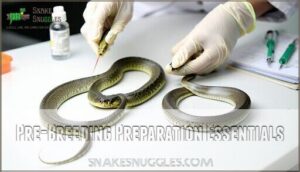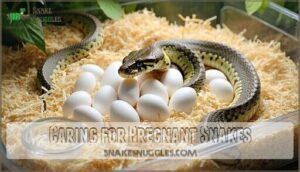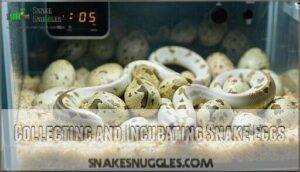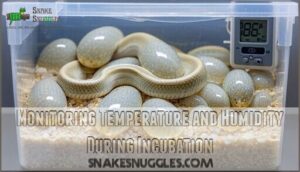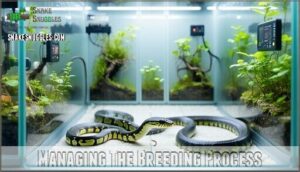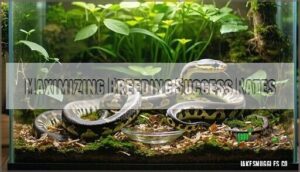This site is supported by our readers. We may earn a commission, at no cost to you, if you purchase through links.
 Your snake breeding success rate factors boil down to getting the basics right.
Your snake breeding success rate factors boil down to getting the basics right.
You’ll need healthy breeding pairs free from genetic issues, proper temperature cycling that mimics natural seasons, and humidity levels between 50-80%.
Think of it like matchmaking – timing matters.
Most snakes require a cooling period followed by gradual warming to trigger breeding behavior.
You can’t rush Mother Nature.
Feed your snakes well before breeding season, then stop feeding during cooling.
Monitor courtship behaviors closely, because missed signs mean missed opportunities.
Incubation temperature affects both hatch rates and offspring sex ratios.
The devil’s in the details when maximizing your breeding outcomes.
Table Of Contents
- Key Takeaways
- Pre-Breeding Preparation Essentials
- Choosing Healthy Snakes for Breeding
- Setting Up Ambient Conditions
- Introducing Snakes and Mating
- Caring for Pregnant Snakes
- Caring for Snake Eggs and Hatchlings
- Managing The Breeding Process
- Recognizing Unhealthy Snakes and Genetic Risks
- Creating a Safe and Healthy Breeding Environment
- Maximizing Breeding Success Rates
- Frequently Asked Questions (FAQs)
- Are snakes hard to breed?
- Do female snakes eat male snakes after mating?
- What is common during snakes’ breeding season?
- How many baby snakes does a snake usually have?
- How to maximize your profitability in snake breeding?
- Do snakes breed well?
- What does it take to breed a snake?
- Why do snakes need to be bred?
- How can I improve snake hatchling survival?
- What are common mistakes in snake breeding?
- Conclusion
Key Takeaways
- Master environmental controls first – You’ll need to maintain precise temperature gradients (60-85°F, depending on species), humidity levels between 50-80%, and implement proper cooling periods of 60-90 days to trigger natural breeding instincts.
- Select healthy breeding pairs carefully – You can’t rush genetics, so choose mature snakes that are free from health issues, maintain genetic diversity to avoid problems like wobble syndrome, and ensure that proper age and weight requirements are met.
- Time your breeding cycles correctly – You’ll boost success rates by separating sexes before cooling, stopping feeding during the cooling period, and closely monitoring courtship behaviors, like tongue flicking and tail lifting, to catch optimal mating windows.
- Focus on incubation and hatchling care – You’ll achieve 80-90% hatch rates by maintaining consistent incubation temperatures, providing proper humidity control, and offering appropriately sized prey to hatchlings, while minimizing handling stress during their first critical weeks.
Pre-Breeding Preparation Essentials
You’re about to learn the essential steps for pre-breeding preparation, which is vital for successful snake breeding.
Master pre-breeding prep and watch your snake breeding success soar to new heights!
By separating sexes, stopping feeding, and controlling temperature and humidity, you’ll be setting your snakes up for a healthy and productive breeding season.
Separating Sexes and Stopping Feeding
To boost your snake breeding success rate, two steps always kick things off: separate sexes and stop feeding. These moves are important for snake stress reduction and prepping their bodies.
A two-week pre-breeding period is essential. You’ll separate male and female snakes into different tanks.
Here’s why it matters:
- Minimize aggression between potential mates
- Clears digestive system for good health
- Allows you to monitor health
- Prevents accidental breeding
- Simulates natural conditions
Remember, you’re mimicking nature’s internal clocks, getting them ready. Don’t worry about snake lethargy. You’re helping trigger instincts. These are key snake breeding factors.
Cooling Period and Temperature Control
You’re now focusing on the cooling period, a key step in snake breeding.
This phase simulates seasonal changes, triggering reproductive instincts. For ideal results, use a thermometer to monitor temperatures.
Species like ball pythons and corn snakes require 60-90 days of cooling at specific temperature ranges (70-75°F and 55-65°F, respectively).
Understanding the ideal breeding temperature and brumation length for your species is key to a successful snake breeding success rate.
You may need a snake cooling thermometer to maintain ideal temperatures.
By controlling environmental temperatures, you can create a suitable temperature gradient for seasonal simulation, increasing your chances of success.
Humidity and Photoperiod Management
You’ll manage humidity and lighting to simulate seasonal changes.
Keep humidity between 50-70% and maintain 10-12 hours of daily lighting for ideal snake breeding conditions.
Ensuring enclosure ventilation and humidity control is crucial for a successful breeding environment.
Duration of Cooling Period
After humidity and lighting, the cooling length is next. The duration of the snake brumation period affects snake breeding success.
Different species need different times. Temperate snakes need 8-12 weeks. Tropical snakes need less. Getting this right is like Goldilocks finding the perfect porridge. Not enough, and they won’t be interested. Too much, and you might stress them. Nail this, and you’re closer to snake breeding success with proper breeding temperature control.
- Frustration
- Excitement
- Joy
- Relief
Choosing Healthy Snakes for Breeding
You’re about to choose healthy snakes for breeding, which is a vital step in ensuring a successful breeding program.
By researching popular species, evaluating breeding requirements, and selecting snakes based on age, weight, and overall health, you’ll be well on your way to creating a thriving breeding environment with healthy snakes.
Researching Popular and In-demand Snake Species
You’re diving into snake breeding, and selecting popular species is key.
Consider market trends, like corn snakes being in high demand.
Factor in care needs and profit potential, ensuring ethical considerations and legal compliance.
Research high-demand species, such as ball pythons and royal snakes, to maximize your snake breeding success rate.
Evaluating Breeding Requirements and Potential Challenges
You’re about to undertake a snake breeding journey. Evaluating breeding requirements and potential challenges is vital.
Consider:
- Market demand
- Breeding costs
- Legal compliance
- Ethical concerns
- Genetic diversity
To achieve a high snake breeding success rate, analyze these factors. Be aware of snake breeding challenges and requirements. Prioritize ethical concerns, legal compliance, and cost analysis.
By doing so, you’ll mitigate snake breeding health considerations and increase your chances of success. Stable temperatures and humidity, essential for snake breeding health, are also key.
Setting Up Ambient Conditions
You’re about to set up the perfect environment for your snakes to thrive, and it’s vital to get it just right.
By creating temperature gradients, maintaining ideal humidity levels, and providing proper lighting and ventilation, you’ll be well on your way to boosting your snake breeding success rates.
Creating Temperature Gradients for Breeding
You’re crafting a Gradient Design for snake breeding conditions.
Invest in a reliable Heat Source and Thermostat Control to guarantee temperature stability.
Monitor temperature gradients with advanced Monitoring Tools to meet Species Needs.
Snakes require specific temperature control products for proper breeding.
A well-designed snake breeding enclosure requires careful planning, considering temperature gradients and humidity levels to optimize breeding success with the right temperature control.
Maintaining Humidity Levels for Snake Health
You’re now focusing on maintaining ideal humidity levels for snake health.
To prevent shedding problems and respiratory infections, aim for 50-70% humidity.
Here’s how:
- Monitor humidity levels
- Choose the right substrate
- Select a suitable water bowl
- Invest in accurate humidity gauges.
Digital hygrometers guarantee precise readings.
Proper humidity monitoring is key to snake breeding success rate, guaranteeing proper hydration levels and preventing health issues.
Providing Proper Lighting and Ventilation
You manage lighting and ventilation to balance temperature and humidity, ensuring healthy snakes.
Proper lighting spectrum and ventilation methods maintain air quality, while natural light influences behaviors and hormone cycles in your enclosure setup, affecting temperature, humidity, and overall snake breeding success.
Many breeders source snake enclosure lighting from online retailers, which is crucial for healthy snakes.
Introducing Snakes and Mating
You’re now ready to introduce your snakes and facilitate mating, a vital step in the breeding process.
By monitoring courtship behaviors and recognizing signs of successful mating, you’ll be able to guarantee a healthy and productive breeding experience for your snakes.
Monitoring Courtship Behaviors and Mating Rituals
Now that the ambient setup is dialed in, how do you spot romance? Watch for snake courtship behaviors, like tongue flicking. Male dominance displays are common.
Females may signal they’re ready by lifting their tails. Don’t miss snake mating rituals, including pheromone detection, which can boost the snake breeding success rate.
Remember, nest site selection is critical for reproductive success!
- Courtship dances
- Mating behavior
- Mating duration
Recognizing Signs of Successful Mating
You’ll observe courtship behaviors like tongue flicking and pheromone trails.
The male will show interest, and if the female is receptive, she’ll exhibit tail lifting and cloaca gaping.
Successful mating can last over an hour, boosting your snake breeding success rate with proper observation of these key behaviors.
Caring for Pregnant Snakes
You’ll need to provide proper care for your pregnant snakes, including a suitable enclosure and nutritious food.
By monitoring their health and gestation period, you can help guarantee a successful breeding experience and a healthy litter of snakes.
Providing Proper Housing and Nutrition
To boost snake breeding success, provide a spacious enclosure with suitable substrate choices.
Feed your snake larger meals regularly, adding dietary supplements for superior nutrition.
Provide easy water access, as hydration is vital.
Consider a high-quality breeding enclosure with proper temperature and humidity controls.
A well-designed enclosure size and substrate can make a big difference in your snake’s comfort and breeding success.
Proper feeding frequency and nutrition are also essential for a healthy pregnancy.
Monitoring Health and Gestation Period
You’ve nailed the diet, now keep a close watch! Monitoring your pregnant snake’s health is essential. Track her weight changes regularly; it offers insights into gestation length and egg development.
Confirm suspicions through snake pregnancy confirmation methods. Here’s what to watch for:
- Weight changes
- Snake health assessment
- Egg development
- Veterinary checkups
- Hatchling viability
Treat her enclosure like a nursery, ensuring proper incubation. This hands-on approach boosts your snake breeding success!
Caring for Snake Eggs and Hatchlings
You’re now responsible for the delicate snake eggs and hatchlings, requiring precise care to guarantee their survival.
You’ll need to carefully collect and incubate the eggs, monitoring temperature and humidity, and provide proper nutrition for the hatchlings to thrive.
Collecting and Incubating Snake Eggs
You’re now collecting snake eggs. Handle them gently, using incubation equipment for a cozy environment.
- Protect each egg
- Guarantee right humidity
- Use reliable equipment
Anticipate successful hatching, focusing on egg handling and incubation mediums for healthy snake eggs and proper embryo development, ensuring a successful outcome.
Monitoring Temperature and Humidity During Incubation
You’ll use incubation thermometers and humidity control to maintain ideal temperature and humidity levels for snake egg incubation, ensuring proper egg development and a high hatch rate.
While also preventing mold and maintaining ideal snake humidity levels with a reliable snake breeding thermometer, this ensures high hatch rate and overall success in snake breeding.
Providing Proper Care and Nutrition for Hatchlings
You’re now feeding hatchlings, starting with appropriately sized prey like pinky mice.
Establish a consistent feeding schedule and monitor growth.
Guarantee access to water and handle them gently to minimize stress.
Proper enclosure size is vital, and supplementing diets can promote healthy development, all contributing to successful snake hatchling survival and overall hatchling health.
Managing The Breeding Process
You’re now managing the breeding process, which requires careful planning and attention to detail.
By understanding breeding cycles and behaviors, introducing male and female snakes for mating, and monitoring breeding activities, you’ll be well on your way to achieving successful breeding outcomes.
Understanding Breeding Cycles and Behaviors
Discover the secrets of snake reproduction! Understanding snake breeding cycles and behaviors is key for snake breeding success rate.
Watch for courtship behaviors like head bobbing. Observe mating behavior and pheromone detection, signs your snakes are ready.
- Courtship Rituals
- Combat Behavior
- Mating Plugs
Knowing these cues helps predict egg-laying and hatchling care. Remember, asexual reproduction isn’t always an option, and understanding courtship behaviors is crucial for successful breeding.
Introducing Male and Female Snakes for Mating
When introducing male and female snakes for mating, create a stress-free environment.
Watch for courtship signs like tongue flicks and body bobbing, ensuring pairing compatibility to boost success rates and reduce stress, focusing on breeding pair compatibility and ideal mating environment.
Monitoring and Documenting Breeding Activities
You’re now monitoring breeding activities.
Track mating frequency, egg development, and hatchling health using:
- Enclosure logs
- Breeding records
- Environmental logs
- Behavioral observations to boost success rates with thorough documentation and breeding analysis.
To ensure the best results, it is crucial to have thorough documentation.
Recognizing Unhealthy Snakes and Genetic Risks
You’ll want to recognize unhealthy snakes and genetic risks to guarantee a successful breeding program.
By identifying signs of health issues and understanding genetic risks, you can make informed decisions about snake selection and breeding pair compatibility, which is crucial for a successful breeding program with minimal genetic risks.
Identifying Signs of Health Issues in Snakes
You’ll boost snake breeding success by watching for lethargy signs, shedding problems, appetite changes, scale abnormalities, and respiratory issues, which can indicate poor snake health.
These health concerns include eye problems and skin conditions, to address these health concerns promptly, which is crucial for snake health and can be indicated by issues such as lethargy.
Understanding Genetic Risks and Responsible Morph Selection
You’re playing genetic detective with responsible morph selection, avoiding morph-related issues like wobble syndrome.
Consider:
- Genetic diversity
- Inbreeding avoidance
- Ethical morphs to guarantee healthy snakes, prioritizing genetic risks and responsible morph selection.
Responsible breeders also maintain transparency about genetic risks to promote well-being, ensuring healthy snakes through their practices.
Creating a Safe and Healthy Breeding Environment
You’re about to create a safe and healthy breeding environment for your snakes, which is essential for their well-being and breeding success.
By maintaining proper temperature and humidity levels, and providing appropriate hiding spots and nesting areas, you’ll be setting your snakes up for a successful breeding experience.
Maintaining Proper Temperature and Humidity Levels
You master thermal gradients and humidity control by maintaining 75-85°F temperatures with 60% humidity.
Using monitoring tools like thermometers and hygrometers to guarantee ideal breeding conditions and ventilation needs for a high snake breeding success rate is crucial.
Providing Appropriate Hiding Spots and Nesting Areas
You create a snake breeding environment with multiple hiding spots using logs or cork, offering a variety of nesting materials.
This boosts your snake breeding success rate. Proper substrate depth and spatial arrangement in the enclosure provide security, while hiding variety reduces stress.
Choose the right nesting materials to make your snake breeding a success.
Maximizing Breeding Success Rates
You’re about to learn the key factors that affect snake breeding success rates, and it’s essential to understand these elements to improve your breeding outcomes.
By recognizing the importance of proper environment, healthy snakes, and ideal breeding conditions, you can increase your chances of successful breeding and raise healthy offspring.
Understanding Factors Affecting Breeding Success
Understanding the factors affecting snake breeding success is like solving a puzzle. You’ve got to take everything into account.
Successful snake breeding isn’t luck—it’s mastering the puzzle pieces of genetics, nutrition, and perfect timing.
Here’s what influences your snake breeding success rate:
- Genetic diversity: Prevents issues like stunted growth.
- Nutritional impact: Proper feeding boosts fertility.
- Mating compatibility: Size and temperament matter.
- Incubation success: Temperature and humidity are key.
The right habitat reduces environmental stressors, which affects snake reproduction rate. Reptile breeding factors include enclosure size and environmental control.
Maintaining proper humidity is essential. A snake’s breeding health reflects its living conditions. Think of it as their Goldilocks moment. You want everything just right for breeding success!
Implementing Strategies for Improved Breeding Outcomes
Several key strategies dramatically boost your snake breeding success rate. Genetic screening prevents inherited disorders while nutritional optimization strengthens breeding pairs.
Environmental enrichment reduces stress, improving hatchling vigor. Time introductions with natural cycles—breeding outcomes improvement happens when you align with seasonal patterns.
Monitor feeding responses and behavioral cues. These breeding strategies work together, creating ideal conditions for reptile breeding factors success.
Frequently Asked Questions (FAQs)
Are snakes hard to breed?
Breeding snakes isn’t exactly rocket science, but it’s no walk in the park either.
You’ll need patience, proper setup, and knowledge of species-specific requirements.
Success depends on temperature control, timing, and healthy breeding pairs.
Do female snakes eat male snakes after mating?
Female snakes don’t typically eat males after mating like some spiders do.
However, you’ll find larger females might occasionally consume smaller males if they’re hungry and perceive them as prey rather than mates.
What is common during snakes’ breeding season?
During breeding season, you’ll notice increased male aggression, territorial combat, and intense courtship behaviors.
Males actively track females using pheromones, while females become more selective and may refuse food as their bodies prepare for reproduction.
How many baby snakes does a snake usually have?
Pythons can lay up to 100 eggs at once.
You’ll typically see 6-30 babies per clutch, depending on the species.
Corn snakes average 12-24 offspring, while ball pythons usually produce 4-10 eggs per breeding cycle, which can be considered a complete breeding cycle.
How to maximize your profitability in snake breeding?
Focus on high-demand morphs, maintain detailed breeding records, minimize veterinary costs through preventive care, optimize feeding schedules, and establish relationships with reptile stores and online platforms for consistent sales channels.
Do snakes breed well?
Ironically, these "simple" reptiles are surprisingly complex breeders.
You’ll find snakes breed successfully when you’ve mastered their specific temperature, humidity, and seasonal requirements—but don’t expect beginner’s luck without proper preparation.
What does it take to breed a snake?
You’ll need healthy, mature snakes, proper environmental controls, temperature cycling to trigger breeding instincts, compatible pairs, and patience.
Success requires monitoring health, creating ideal conditions, and understanding each species’ specific reproductive needs.
Why do snakes need to be bred?
Like cultivating rare orchids, you’ll breed snakes to preserve endangered species.
You’ll advance genetic research, maintain captive populations for education.
You’ll meet pet trade demand while contributing to conservation efforts and scientific understanding.
How can I improve snake hatchling survival?
You’ll boost hatchling survival by maintaining proper temperatures around 80-85°F.
Separating babies to prevent cannibalism.
Offering appropriately-sized prey weekly.
And minimizing handling stress during their first few critical weeks of life.
What are common mistakes in snake breeding?
You’ll often rush the cooling period, skip health checks, or breed incompatible pairs.
Don’t forget proper incubation temperatures, overcrowd hatchlings, or ignore genetic diversity.
These rookie mistakes can tank your breeding success rates.
Conclusion
Surprisingly, experienced breeders achieve 80-90% hatch rates while beginners often struggle with 40-50% success.
You’ve learned that snake breeding success rate factors depend on mastering temperature cycling, maintaining proper humidity, and selecting healthy breeding pairs.
Don’t rush the cooling period—your snakes need time to prepare naturally.
Monitor courtship behaviors closely, because timing is everything.
With consistent environmental controls and patient observation, you’ll transform from amateur to expert breeder, remembering that successful breeding is science mixed with careful attention to detail.

